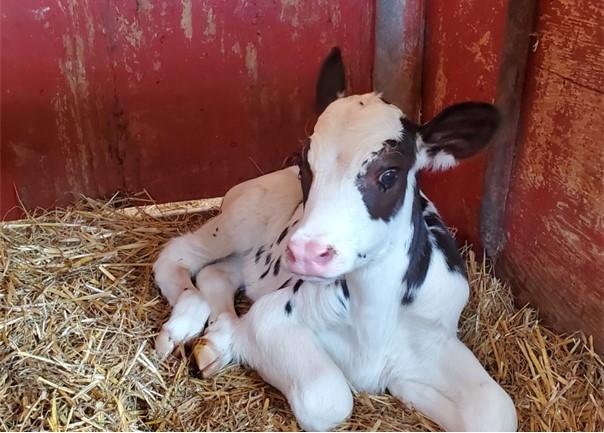It can be frustrating when trying to determine the root cause of calf scours. Taking note of the age at which calves begin to experience scours symptoms can be extremely helpful when trying to pinpoint an infectious cause. If scours appears in calves less than 48 hours old, E. coli or rotavirus could be to blame. If calves are less than 7 days old, then E. coli, rotavirus, or coronavirus are possible culprits. Coronavirus, Salmonella, clostridia, cryptosporidia, and coccidia often affect calves between 1 and 2 weeks of age, while calves who are over 2 weeks of age are more likely to be affected by Salmonella, clostridia, cryptosporidia, or coccidia. A fecal culture can also help clearly define which (if any) infectious agent is causing scours. This can be extremely helpful when determining course of treatment and identify effective preventative strategies. If an infectious agent cannot be pinpointed, it is also important to consider the possibility of noninfectious causes of scours.
Table 1. Potential scours pathogens according to scours onset.
| Age at Onset |
Potential Pathogen |
| 0-48 hours |
E. Coli, rotavirus |
| 1-7 days |
E. Coli, rotavirus, coronavirus |
| 1-2 weeks |
Coronavirus, Salmonella, clostridia, cryptosporidia, coccidia |
| >2 weeks |
Salmonella, clostridia, cryptosporidia, coccidia |
Treatment
The trouble with scours is not the diarrhea itself, but the dehydration that it causes. In most cases, providing scouring calves with oral electrolytes can help mitigate dehydration. When providing oral electrolytes, it is important to follow product mixing instructions. Using too little water can make the solution too concentrated and make scours worse. It is also important to continue offering milk or milk replacer as part of the normal feeding routine. In other words, do not substitute an electrolyte dose for a milk or milk replacer feeding. While they may not drink all of their milk feeding, it should still be offered because proper nutrition can help calves recover quicker. Antibiotics are often not needed to treat scours, but if it coincides with a fever (>103°F), antibiotic treatment may be recommended, so be sure to consult your veterinarian.
Prevention
Prevention is the best course of action when it comes to managing calf scours. Maintaining a clean, dry, and well-ventilated environment is certainly an important part of scours mitigation. This applies not only to calf housing, but also to calving areas. Calves scouring within the first few days of life could indicate an issue related to calving area sanitation. To prevent pathogen transfer among calves, be sure to clean all feeding equipment, such as bottles or buckets, in between calves. Feeding older calves before younger calves and any sick calves last can also help reduce the potential for transferring infectious agents between calves. Finally, always be sure to clean individual calf housing, such as pens or hutches, in between calves.
Good colostrum management is also critical for developing the calf’s immune system. Colostrum management can be evaluated by examining colostrum quality before feeding using a Brix refractometer or colostrometer. As a rule of thumb, a Brix reading of >22% or a colostrometer reading of >50 g IgG/L is indicative of good quality colostrum. Calves should receive 10% of their body weight of good quality colostrum within the first 12 hours of life. Ideally, this would be split into two feedings, with the first occurring within 2-4 hours of birth and the second at 12 hours after birth. Colostrum effectiveness can be evaluated by taking a blood sample from calves between 2 to 7 days of age and assessing serum total protein levels. On-farm, a Brix refractometer can be used for this and a serum total protein >15 g/L suggests good passive transfer of immunity.
Milk feeding management is also plays a role in scours prevention. Because calves thrive on consistency, be sure to follow a routine feeding schedule each day. It is also important to follow milk replacer mixing instructions to ensure proper solids content. Feeding milk replacer that is too concentrated (not enough water added) or too dilute (too much water added) can cause scours. Ideally, milk replacer should be mixed to contain 12-13% solids, which can be evaluated on farm using a Brix refractometer.
Vaccinations can also play a role in scours prevention. Vaccinating dry cows 2-6 weeks before calving can boost colostrum antibody concentrations for specific infectious agents. These dry cow vaccines can help reduce calf hood incidence of E. coli, coronavirus, and rotavirus.
Summary
Scours is an inevitable part of rearing dairy calves. However, monitoring colostrum management, utilizing good sanitation practices, ensuring good milk feeding practices, and adopting a dry cow vaccination program are all tools that can be used to help prevent and reduce the economic impact of scours.
This article appears on June 16, 2022, Volume 3, Issue 2 of the Maryland Milk Moos newsletter.
